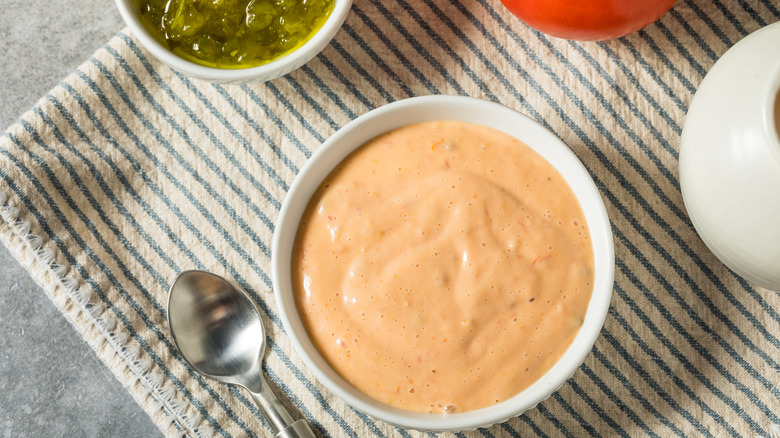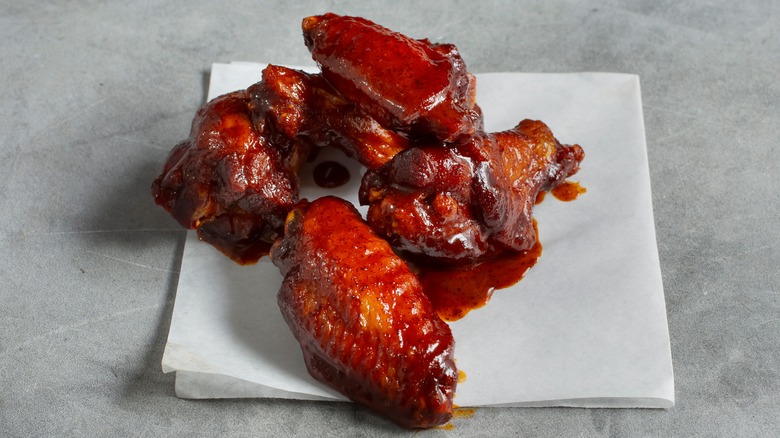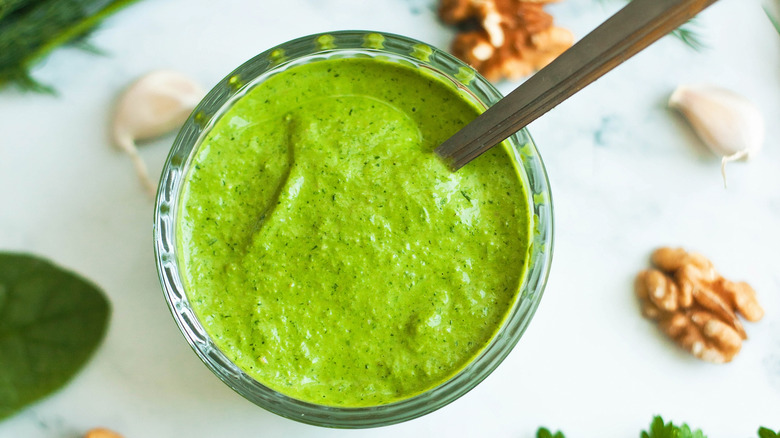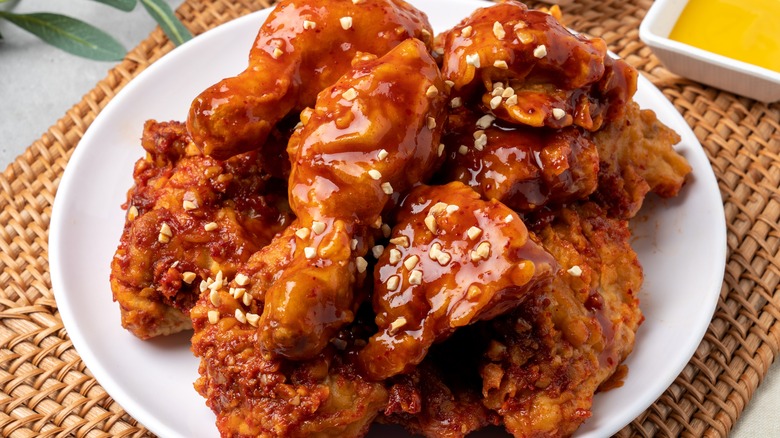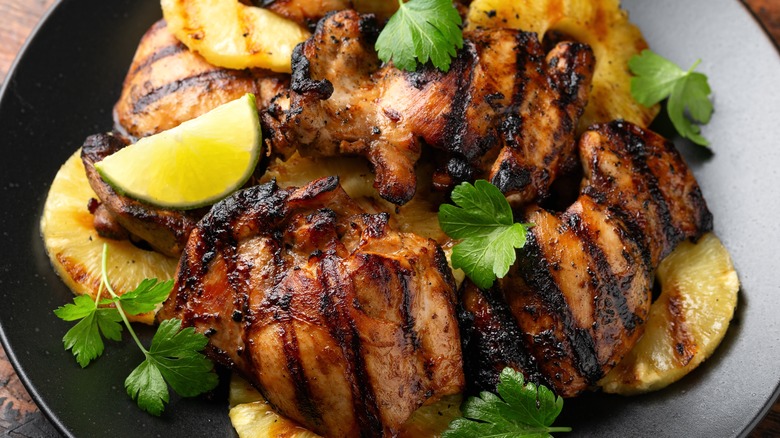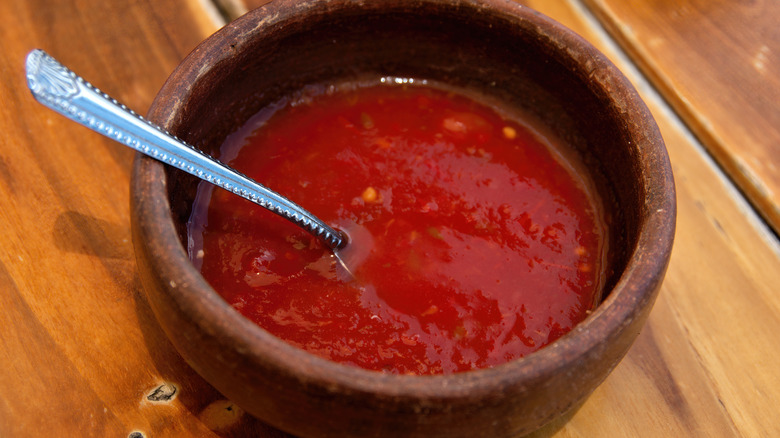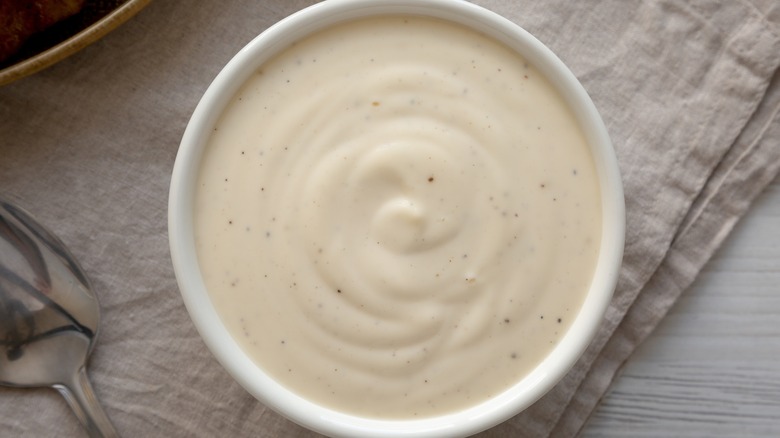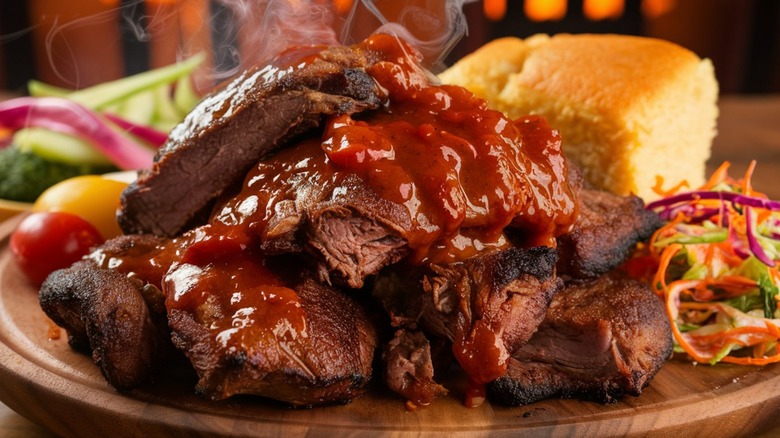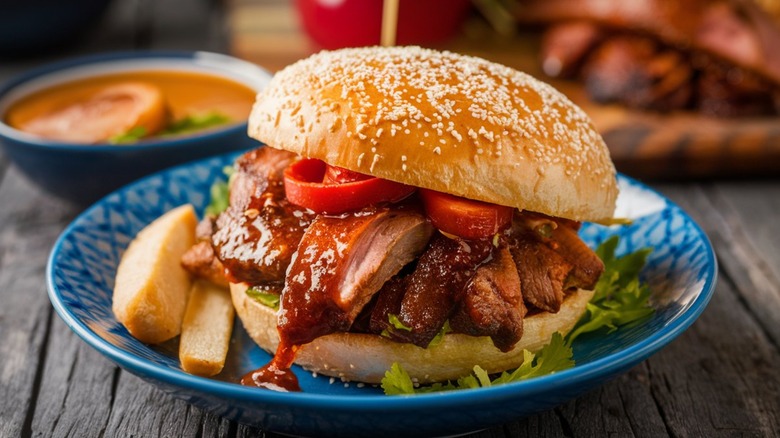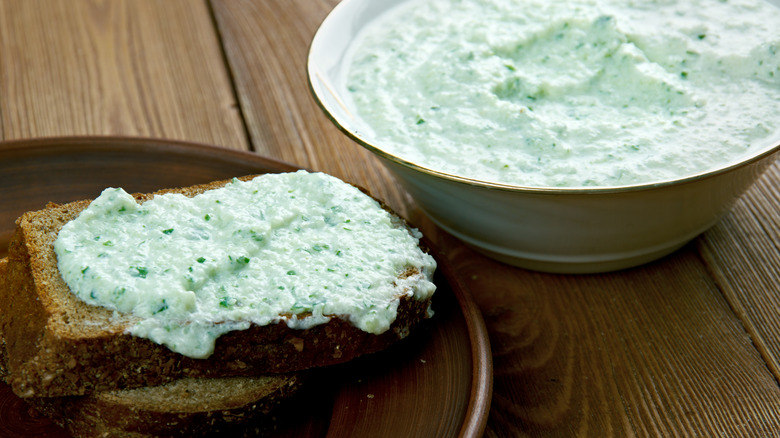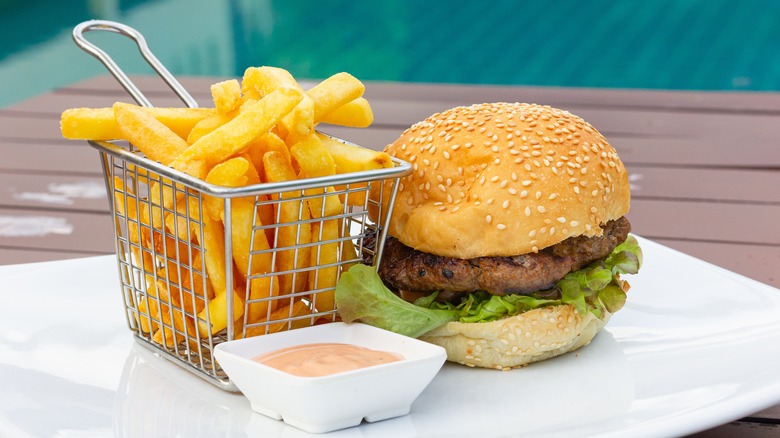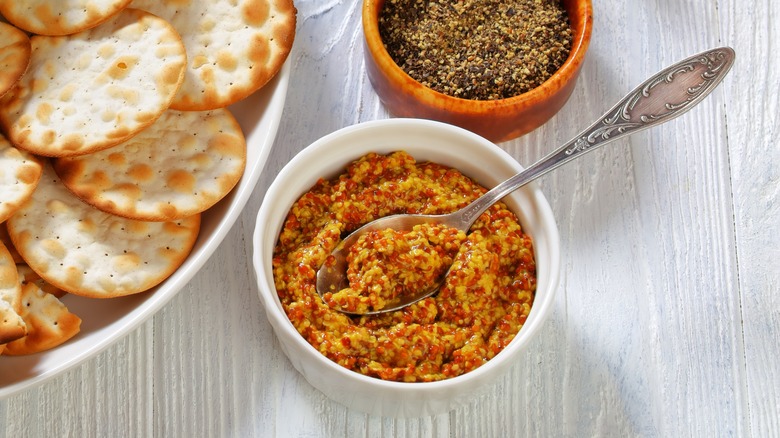11 Regional Sauces You Need To Try Before You Die
Whether you use it for dipping, marinating, or spreading, nothing amps up the flavor of your favorite meal like a good dollop of sauce. And if Americans know about anything, it's sauce — whether it's weighing in on the best fast food chicken nugget sauce or trying your hand at cooking with chain sauces (yes, you can seriously upgrade your mashed potatoes with that old packet of Arby's Horsey Sauce you've got chilling in your refrigerator door). From Alaska to Florida, and everywhere in between, there is some real saucy action going on in the USA.
Sure, ketchup is cute and mayonnaise is good for the everyday, but sometimes those bog standard sauces don't quite cut the mustard. So break out of those saucy confines you've found yourself in, because there's a world of dippable, dunkable deliciousness you've yet to discover. Take inspiration from some of these regional sauces that you need to try before you die.
1. Nashville hot sauce, Tennessee
If you can handle the heat, a hot sauce can seriously ramp up the flavor profile of whatever it is dashed onto. Case in point: Nashville hot sauce. This regional sauce was allegedly invented in the 1930s for the sole purpose of upgrading Southern fried chicken. The people of Tennessee used their famous hot sauce to coat pieces of deep fried chicken, adding a spike of heat to the otherwise mild dish.
The sauce, which is typically made up of cayenne pepper, paprika, sugar, onion powder, garlic powder, and salt, is whisked with either melted butter or oil. This is what sets it apart from other hot sauces, which are usually vinegar-based. Using oil or butter as the base mellows the heat a little, and allows the spices to infuse into the sauce, making it the perfect condiment for coating fried chicken. If you can't make it to the famous Prince's in Tennessee to taste for yourself, then have a go at making your own authentic Nashville hot chicken.
2. Green Goddess, California
Green Goddess dressing really had its moment in the Californian sun when it went viral in 2023, with the Green Goddess salad trend that took over social media feeds. But despite it going viral only recently, Green Goddess sauce is actually a little older than you'd think. According to the Cape Gazette, the dressing was created by chef Philip Roemer, who was cooking at the Palace Hotel in San Francisco when actor George Arliss came to stay. At the time (all the way back in 1923), Arliss was in a play called "The Green Goddess," thus the name for this green-hued sauce was born.
But what's actually in a Green Goddess sauce? It's changed a lot in the last 100 years, but it is usually packed with herbs like parsley, cilantro, and basil, as well as avocado alongside a mayonnaise-like base. This Green Goddess dressing recipe calls for emulsifying an egg yolk with oil to make a homemade mayonnaise, before combining it with the rest of the ingredients. And boy is it worth the effort. Once created, this sauce makes a great addition to sandwiches, tacos, and, of course, that famous salad.
3. Mild sauce, Illinois
If you've had the joy of eating at Harold's Chicken Shack, then you've likely also had the joy of eating the mild sauce that was born at this Chicago-founded fast-food joint. Harold, the eponymous owner, created the mild sauce as an accompaniment to his menu of fried chicken, fried fish, fried pickles, and plain old fries. The sauce is tangy and sweet enough to cut through heavy meals and well suited to grease-forward meals as well. When the Chicago Tribune sent a reporter to try mild sauce for the first time, he reported that "The sauce acted almost like a glaze on the chicken pieces, gently clinging to the crackling crisp coating." Pretty delicious.
The issue with this delicious sauce is that there is no fixed recipe. There are, however, some standard ingredients that crop up. Tomato paste, ketchup, sweetener, mustard powder, vinegar, and spices are all key. Savvy foodies of the internet have figured out a couple of hacks to create solid copycat versions of the sauce. One simple way is by mixing ketchup, hot sauce and BBQ sauce. Or, take it one step further with a two-ingredient recipe. As it turns out, mixing Russian dressing and Frank's Red Hot sauce gives a similar flavor to Harold's mild sauce. However you make it, your fried food will take on a new, zingy lease on life after it has had a dunk.
4. Huli-huli sauce, Hawaii
Considering its island origins, it's unsurprising that huli-huli sauce is such a fruity number. It's got both pineapple and orange juice, plus a savory hit from tamari, garlic powder, and onion powder. There's also ketchup, vinegar, and mustard for some zing, plus cornstarch to help thicken the whole thing. There are variations out there, with some recipes swapping out orange juice for another citrus, or tamari with soy sauce if that's what you've got in the cupboard.
Once you've made your huli-huli, you have a very versatile sauce on your hands. Of course, it makes for a great sauce to use as a dip, but it can also be used as a marinade for proteins, as well as a dressing for salads, pasta, and rice. One of the most iconic ways to enjoy the sauce is on huli-huli chicken, a marinated rotisserie chicken that's slowly cooked, resulting in sweet and savory grilled meat. Or, you could get even more creative and mix the sauce into a mayo for an adventurous topping for your next batch of tater tots. Huli-huli sauce is versatile enough to enjoy in either a traditional fashion or in your own way.
5. Red hot sauce, Louisiana
New Iberia, Louisiana, might be known as the birthplace of politician Kathleen Blanco, the only city in the country that uses three languages for its historical signposts, or for being the home to the oldest operating rice mill in the country. But you know what else this city is known for? Its hot sauce.
Not one, but two hot sauce brands call New Iberia home. The idea for Frank's Red Hot sauce was thought up by two New Iberia residents in 1918, and two years later the first ever bottle of the sauce was made using a blend of cayenne peppers. Louisiana Hot Sauce began its life just a few years later in 1928. The sauce is made by fermenting peppers with vinegar and salt to create a balanced result.
So yes, New Iberia really is the place to be if you like a spicy sauce. But what is the difference between the two brands? While Louisiana Hot Sauce is more vinegar-forward, giving it a tangier taste and thinner texture, Frank's Red Hot sauce has an addition of garlic and water to reduce the vinegar flavor. But don't be fooled, because both of these hot sauces pack a warming 450 Scoville units worth of spice.
6. White sauce, Alabama
You don't have to be a rocket scientist to figure out what color this Alabama sauce is. But what ingredient give it its signature, creamy color? According to this Alabama white sauce recipe, it comes from a mixture of apple cider vinegar, brown sugar, mustard, lemon juice, Worcestershire sauce, salt, pepper, Old Bay seasoning, red pepper flakes, and a good load of mayonnaise. The combination will give you a tangy, slightly zippy, and creamy BBQ sauce that works a treat on some of your favorite meals.
The sauce was invented by Robert Gibson of Big Bob Gibson's B-B-Q, a chain restaurant that was founded back in 1925. Bob decided he wanted to create a BBQ sauce that was a bit different to the regular ketchup-based sauces. So he turned to ketchup's creamy cousin, mayonnaise, and white sauce was born. The sauce makes for a great accompaniment to many summer time grilling staples, like this quick and easy half BBQ chicken recipe. Or, upgrade your tomato sandwich by swapping out regular mayonnaise with Alabama white sauce for a more complex flavor profile.
7. Kansas City BBQ sauce, Missouri
On the topic of BBQ sauces, we'd be remiss to neglect Kansas City and its famous BBQ sauce. What makes Kansas City BBQ sauce unique to its other saucy competitors is the fact that it is thick, sweet, and slathered directly onto whatever meat is coming off the grill. In this perfectly sweet sauce, the sugar comes in the form of apple juice, tomato ketchup, brown sugar, and molasses. When all of these are simmered together (along with spices, vinegar, and onion), the sugar turns the sauce into the thick condiment that is so recognizable as Kansas City BBQ sauce.
So when you're planning your next cookout, don't forget to have some homemade sauce at hand, a surefire way to impress your guests. You can also use it to marinate these juicy slow cooker ribs, or go one step further and incorporate it into your dessert to balance flavors. There's a reason that Kansas City has crowned itself the BBQ capital of the world. Try out the BBQ sauce and see if you think it's a worthy title.
8. Carolina vinegar sauce, North Carolina
According to Reddit, North Carolina's official food is a pulled pork sandwich. But not just any pulled pork sandwich, oh no. This pulled pork sandwich is different from its piggy competitors because of the addition of a sauce that's very specific to North Carolina. Vinegar sauce is what we're talking about, and it's this tangy, BBQ-style sauce that North Carolina locals are so proud of. Most recipes use apple cider vinegar as the main component, as well as brown sugar, ketchup, cayenne pepper, red pepper flakes, salt, and pepper.
It's no wonder this sauce is so popular, since there's a scientific reason why vinegar is so good for food flavor. Not only will the zing of an acid-based sauce help to balance the rich fattiness of a pulled pork sandwich, but the vinegar will also react with the protein molecules in the meat to tenderize the pork, meaning the whole sandwich is levelled up. So the next time you decide to make a slow cooker pulled pork sandwich, make sure you've got your Carolina vinegar sauce ready to zhuzh it up.
9. Benedictine, Kentucky
Jennie C. Benedict was a pivotal figure in the culinary history of Kentucky. This was a woman who, in addition to running her own tearoom, training as a cook at the Boston Cooking School, and selling school lunches, also created one of the most notable sauces in the Louisville, Kentucky region. The aptly named Benedictine spread came about in the early 20th century, when Jennie whipped up a recipe to use as a filling for finger sandwiches. The cucumber-and-cream-cheese spread has since become synonymous with the Kentucky Derby, and happens to be one of Kentucky Derby chef Kenneth Hardiman's favorite classic foods.
Sort of like an upgraded cucumber sandwich, Benedictine sauce is made with the juice of grated cucumber and onions, cream cheese, and seasonings. The resulting mixture is an easy-to-slather spread for sandwiches or a dip for crackers. So at your next Kentucky Derby watch party, if need some crowd-pleasing recipes to go with your mint juleps, you should certainly bring the Benedictine.
10. Fry sauce, Utah
This one really does what it says on the tin. Fry sauce, quite literally, is a sauce made for dipping fries in. And really, it's about as humble a sauce as you can get. A simple mix of mayonnaise and ketchup makes for a pink-hued dunking dream. But though the sauce itself might be a simple affair, its history is far from simple.
Don Carlos Edwards, the founder of a Utah fast food chain restaurant Arctic Circle, originally took the glory for creating fry sauce. The chain announced that mixing ketchup and mayonnaise was Edwards' way of increasing efficiency in the 1950s. However, an opposing theory later surfaced. Two kids, it's said, were working the night shift at an Artic Circle franchise and playing with their food when they accidentally created the iconic sauce.
Whichever tale you choose to believe, one thing is for certain: Fry sauce is here to stay. If you can't find it in yourself to make your own, then Heinz sells Mayochup which is, you guessed it, mayonnaise and ketchup in a bottle. Cook up some copycat McDonald's fries and you've got an excellent fried snack just around the corner.
11. Creole mustard, Louisiana
The world of mustards is rich and diverse, and once you begin dabbling with the spicy yellow sauce, it can become a little overwhelming. With all the different mustards out there, it can be tough to work out which ones are worth spending your dollars on at the grocery store. But let us be a voice of clarity amongst all the noise, because there is one type of mustard you should definitely try before you die.
Creole mustard hails from Louisiana and is a little different to others because of the additional kick from those Louisiana spices. Creole seasoning (paprika, oregano, thyme, garlic powder, onion powder, ground cayenne pepper, black pepper, white pepper, and salt) is blended into a mustard base for a familiar, flavorful taste that is unique to this Southern state. The mustard is a traditional topping for po'boy sandwhiches, but it's a versatile sauce that is also good on other sandwiches and casual dishes. For example, Creole mustard might just be the lift your potato salad is looking for!
